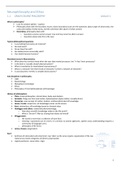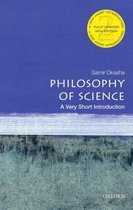Neurophilosophy and Ethics
1.1 CRASH COURSE PHILOSOPHY Lecture 1
What is philosophy?
Love for wisdom (philos – sophia)
Philosophy deals with the boundary issues; classic boundary issues are the questions about origin of what exists, the
unity and totality of what exists, and the coherence (the ‘glue’) of what consists
Rosenberg: philosophy deals with
o Questions science cannot answer now and may never be able to answer
o Questions about why this is the case
Typical philosophical questions:
Is everything that exists just material?
Do souls exist?
Do we have free will?
Are duties/norms universally valid?
Can robots become humans?
Boundary issues in Neuroscience:
What does the scientist mean when she says that mental processes ‘are’ ‘in fact’ brain processes?
Is the brain a ‘causally closed’ physical system?
What is translation (in translational neuroscience)?
What is a network? Are there kinds of networks? Is there a network of networks?
Is consciousness ‘merely’ a complex brain process?
Sub disciplines in philosophy:
Logic
Epistemology
Metaphysics (ontology)
Ethics
Philosophy of mind (philosophical anthropology)
History of philosophers:
Plato: Greek philosopher; eternal ideas; body-soul dualism
Aristotle: things are form and matter; hylemorphism (hyle=matter; morphè=form)
Descartes: new concept of matter; dualism; mathematical ideal of knowledge
Hume / Locke: empiricism; all knowledge comes via the senses
Kant: rationalism; all knowledge based on (innate) ideas
Heidegger and others: existential phenomenology;
o How does scientific knowledge relate to the life world?
o What is ‘Da-sein’? Man as a being that relates to himself
Witggenstein:
o the world is more than a collection of bare facts
o meaning = (practical) use of a term; it is intrinsic to actions (gestures, speech acts); understanding requires a
community of language users;
o philosophy of life forms
James, Dewey: pragmatism
Kant:
Synthesis of rationalism and empiricism; raw ‘data’ via the sense organs; organization of the raw
material via innate categories and forms of perception
Logical positivism: sense data + logic
1
,History:
Science for almost 2000 yrs under the spell of Aristotle’s doctrine of the four causes
o Material (the bricks of the building)
o Formal (the blueprint of the building
o Efficient (the process that brought about the building)
o Final (aim or purpose of the building; ‘telos’)
The great change around 1500-1600: turn to empirical reality + application of mathematical method atomism +
mechanicistic explanations
The other great change: technology, the application of scientific analysis to the process of making and reconstructing (cf.
biology/genetics as ‘reverse engineering’)
Terminology:
Idealism vs Realism
Reduction, abstraction (Methodical reduction vs. reductionism)
Reification (substantialization)
Fallacy
Deontology (dèon: that what has to be done)
Theory – hypothesis – model
1.2 PHILOSOPHY OF SCIENCE Lecture 1
Science: learning how (not so much why) causes and law are different things
Cause: event in time
o But: what exactly is it, that ‘causes’?
Laws
o Strong view: they ‘hold’ (‘necessitate’); however, what exactly is the nature of this ‘holding’ or ‘necessitating’?
o Weak view: they describe regularities; however can there be laws without any reference to a form of
necessitating?
Approaches to scientific explanation:
1. Deductive – nomological approach: top-down; applying laws on sets of phenomena that need to be explained
o D-N model is also referred to as ‘covering law model’; it aims at applying laws on sets of phenomena that need
to be explained
o Initial conditions (description of the phenomena)
o Boundary conditions (factors that need to remain constant; exclusion of interference; ceteris paribus clauses)
o Law(s)
o Criteria:
1. The explanation must be a valid deductive argument.
2. The explanans must contain at least one general law actually needed in the deduction
3. The explanans must be empirically testable.
4. The sentences in the explanans must be true.
o Merits of the D-N model:
1. Compatible with a realist perspective (science is about what ‘really’ exists; science ‘carves nature at its
joints’)
2. It focuses on testable hypotheses
o Problems with the D-N model:
1. Relevance: we don’t know what laws are relevant for the explanandum (the phenomenon that requires
explanation)? Or do we only have a best guess?
2. Probability: D-N approach does not work very well for sciences that make use of statistics (statistics
usually part of an ‘inductive’, bottom-up strategy)
3. Role of ceteris paribus clauses? They multiply (to unworkable amounts of clauses) in other sciences
than physics
4. Is there a difference between generalizations and laws?
2
,2. Inductive-statistical approach: detecting statistical patterns in sets
o Works bottom-up, begins with data, and tries to find patterns and/or regularities (induction)
o It makes use of statistics
o What is a probabilistic explanation? There are, basically, two types:
1. Explanations that are in fact just outcomes of a statistical correlation (keep in mind: correlation is not
causation!)
2. Explanations that make use of ‘probabilistic causes’ like in quantum theory (probabilistic propensities)
or personality theory (disposition; tendencies like character traits); they really signify something about
the nature of reality itself
o Merits of the I-S model:
1. It is a convenient way to generate predictions
2. It has proven to be highly useful in medicine (the EBM [evidence-based medicine] paradigm is based on
the I-S type of explanation)
o Weaknesses:
1. Statistical relations are ‘empty’: they don’t show how things work, how components cooperate to let a
thing (molecule, cell, tissue) function
2. Consequently, whether statistical relations or distributions of probablity really ‘explain’ the
phenomena, remains a matter of debate;
3. There is always the temptation to confuse correlation with causation
3. Counterfactual approach: explanations in terms of necessary and/or sufficient conditions
o Sufficient conditions: conditions that are sufficient to explain the explanandum (the phenomenon that needs to
be explain) (sufficient conditions are rare in science)
o Necessary conditions: conditions that need to exist; in their absence there will be no explanandum (there is no
phenomenon to explain at all)
o Merits of the counterfactual approach:
1. Easy to understand
2. Close to research practices in the life sciences
3. Easy to combine with interventionistic approaches
o Weaknesses:
1. Counterfactual explanations (like I—S explanations) don’t show how things work, how components
cooperate to let a thing (molecule, cell, tissue) function
2. Consequently, whether counterfactual reconstructions really ‘explain’ and give insight into the
phenomena, remains a matter of debate
4. (Neo-)mechanistic approach: Craver, Bechtel
o What is a mechanistic explanation?
1. Explains HOW something happens
2. Identifies the components involved in a phenomenon and HOW these components interact
o Is a form of part-whole explanation
1. A mechanism is a whole
2. The working of the mechanism is explained by the collaboration between all the components within
that whole
o Types of part-whole relationships:
1. Aggregates: the whole does not add anything new to the composition of all the parts (example:
trees – wood)
2. ‘Structural wholes’: parts form a new whole with new properties and lawlike
patterns/regularities; the parts retain relative independence and function according to their own
principles of functioning (example: the functioning of the liver in the human body)
3. Part-whole relations in sense stricto: the parts lose their identity within the whole, they merge
with the whole (example: Gestalt switches as analyzed in psychology)
o Example: Considering this model, provide a mechanistic explanation for how glucose is involved in the
activation of the citric acid cycle glucose is broken down during glycolysis to produce pyruvate. The pyruvate
is converted into acetyl-CoA during pyruvate processing. The acetyl-CoA then activates the citric acid cycle.
o Merits:
1. Easy to understand
2. Close to research practices in the life sciences
3. Easy to combine with interventionistic approaches
3
, o Weaknesses:
1. It is difficult to reach the standard of mechanistic explanation: knowledge of all the relevant
parts/components is an utopia
2. This makes a fully realist interpretation of mechanistic explanation difficult to endorse
3. For those proponents of mechanistic explanation who don’t endorse the realist interpretation, there
remains the age-old question of how adequate the explanation is; does the explanation really carve
nature at its joints or is it just a model?
5. Interventionistic approach (Woodward): a more pragmatic approach that tries to circumvent the problem of adequacy
and ontological relevance
o By studying the effects of interventions under certain boundary conditions
o If an intervention has an effect on the explanandum (C; the illness), than it interferes
with a causal chain that is relevant for C (the illness) and says something (but what
exactly) about its causation
o Merits:
1. It is practical
2. It has had an enormous impact on medicine
o Pitfalls:
1. Effects of interventions do not always reveal the the underlying cause of a disease: aspirin suppresses
fever in infection, but that doesn’t say the prostaglandin metabolism is crucial for the explanation of
infectious disease
2. It does not lead to the understanding of the ‘mechanism’
6. Pragmatic approaches: mixture of inductive-statistical, mechanistic, interventionistic and counterfactual approaches
o They focus on what works, i.e., what has an effect in the real world; and what satisfies the expectations of the
public and of the scientific community
o They represent a position that is opposite to realistic approaches like the D-N and the mechanistic approach
o Merits:
1. It is a way to make progress
2. It tends to be innovative and creative
o Pitfalls:
1. It does not amount to knowledge about the real world
2. Lack of clarity (anything goes)
Philosophy of biology: in biology there exists a different form of explanation
Not by referring to laws, or causes
… but by making use of teleology: functional explanation, functioning of X explained by saying that X works ‘as if’ X is
‘designed’ ‘in order to’ achieve Y (end, goal, purpose; teleology)
The telos is no real telos (purpose), but an ‘as-if’ goal
Medicine: based on two contrasting epistemological strategies
Koch-Virchow, roughly D-N model dysfunctions take the place of laws
Statistical / epidemiological model (which is an inductive-statistical model)
Conclusion: what is the nature of explanation? Only prediction? Is it explanation? A mix of both? Something else?
Overarching question: What is the ‘glue’, the ‘cement of the universe’ (Hume, Mackie)?
o Are explanatory relations only in the mind of the scientist?
o Or are they referring to relations in the real world?
There is a tendency to both in neuroscience:
o There is on the one hand a tendency to realism in the form of reductive materialism
o On the other hand there exists also a widespread pragmatism with respect to methods, ways of presenting
scientific research, concepts, and theoretical underpinning
4






